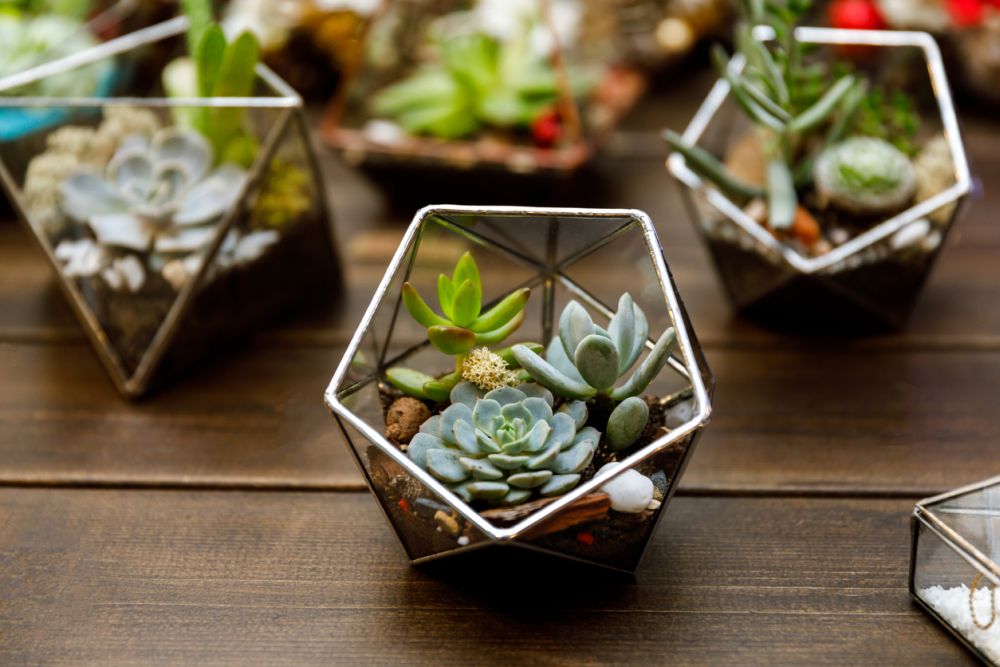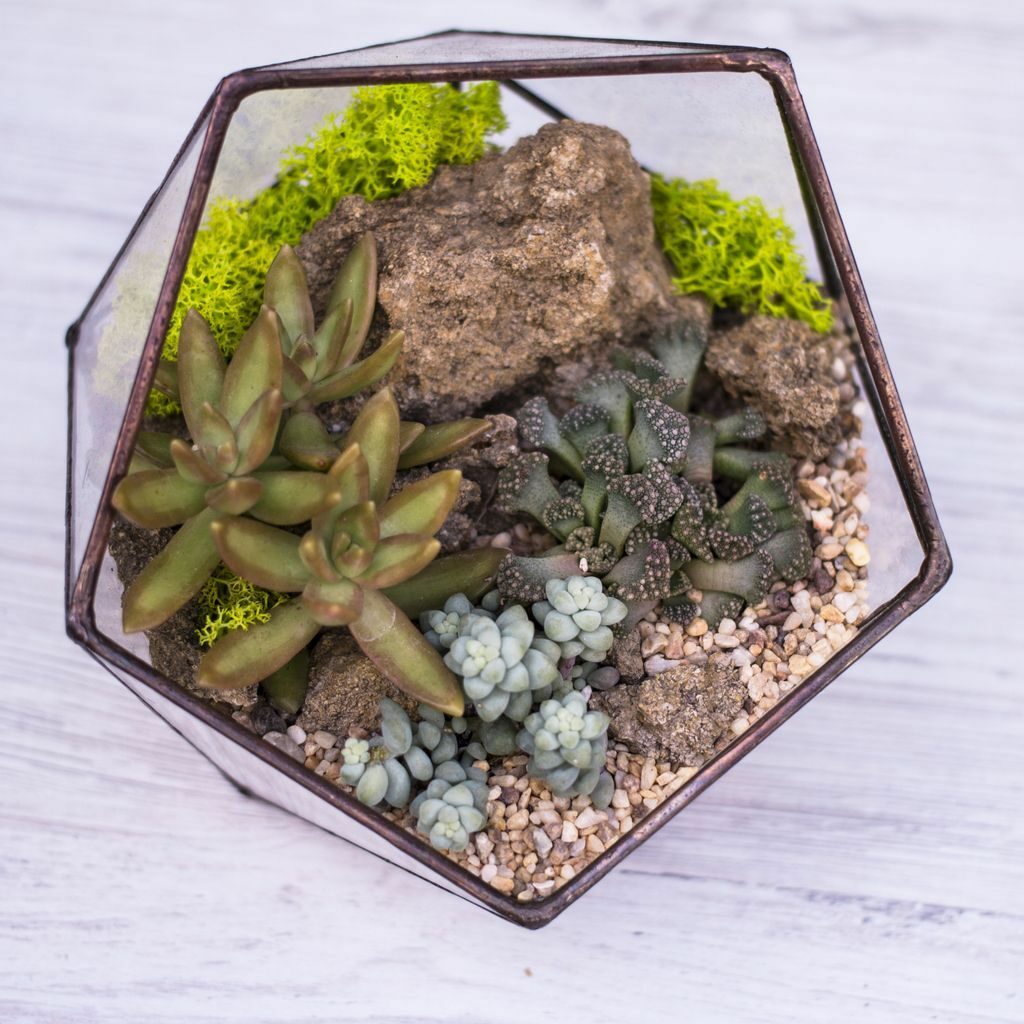Succulent Terrarium Care: How To Make A Succulent Terrarium
A succulent terrarium combines your beloved for plants along with your passion for fine art to create a living and breathing piece of home decor. Dissimilar regular pots, planters, and hanging baskets, a terrarium allows you lot to get as creative every bit you lot like not just with the types of succulents you lot can grouping together, simply also in the accessories and decorations.

The all-time function is, when it comes to delicious terrariums, y'all take many options at your disposal. Based on the colour scheme in your firm and the succulents y'all can get your easily on, y'all can come up up with whatever design you similar.
As for the terrarium type, you always take a choice between open and shut terrariums. Some people adopt an open succulent terrarium since it provides the succulents with better air flow, reduces the take a chance of condensation and mold, and has a better chance of success. That said, closed terrariums accept their fans as well. People favor them considering they are self-sufficient, require zero maintenance, and are better suited to tropical plants also.
If you're new to terrariums, we recommend starting with an open delicious terrarium. Succulents are notoriously easy to abound and intendance for. Likewise, a delicious terrarium e'er looks proficient in whatever setting and gives you a chance to bear witness your gardening skills even if you don't have a garden.
Types of Plants for Terrariums
Succulents accept thousands of species and each has its ain requirements of light, water, fertilizers, and differing lifespan. So, you'll need to choose the right species for your terrarium. Here we group together the unlike succulents that you can grow in the same succulent terrarium based on the weather in your household.
- Vivid Light (Open Terrarium): If you're blessed with enough natural light inside your home all year round, then you have many succulents, air plants, and houseplants to choose from. The nigh probable candidates for an open terrarium under these conditions are Widow's-thrill (Kalanchoe Blossfeldiana), Echeveria, Haworthia, Chocolate soldier (Kalanchoe Tomentosa), Jade (Crassula Ovata), and Sempervivum.
- Medium Calorie-free (Open Terrarium): Not all houses are flooded with bright sunlight 10 hours a day. This is peculiarly true if you live in a low-level flat and you have limited access to sunlight on a normal 24-hour interval. Luckily, some succulents are adapted to filtered light and partial shade. If you're making an open terrarium, you should use ferns especially Fall, Woodland, or Push ferns, Peperomia with a special focus on Parallel, Ripple, or Chinese Money Plant. Other options also include Selaginella, Polka Dot Plant, Dracaena, and Pilea especially Friendship Plant, Glauca, and Depressa.
- Medium Light (Closed Terrarium): For closed succulent terrariums, you can institute Baby's Tears (Helxine Soleirolii), Nerve Plant (Fittonia), Asparagus Fern (Plumosa Nanus), Neanthe Bella Palms, or Oxalis Triangularis.
- Low Calorie-free (Closed Terrarium): And so what if you have dim to low light in your apartment or office? Does that mean yous tin can't take a succulent terrarium? The following succulents come to the rescue. Pillow moss, canvas moss, and mood moss are the type of plants that do well in poor light atmospheric condition.

Materials Needed for a Succulent Terrarium
The materials you lot'll need to make your first delicious terrarium vary depending on the blazon of terrarium (open or airtight), the type of delicious y'all want to grow, and the design you accept in mind. Hither, we'll focus on a general-purpose, open succulent terrarium. The materials yous'll need are the following.
- Glass bowl (similar to a fishbowl or whatsoever shape and pattern of your choosing).
- Delicious plants.
- Perlite or activated charcoal (for managing odors and mucus).
- Pebbles for drainage.
- Peat moss.
- Delicious potting mix.
- Rocks and shells for decoration.
- Garden trowel.
You can add more than materials co-ordinate to your specific needs.
How to Make a Succulent Terrarium
With all the materials at hand and your choice of succulents already on the tabular array, you're gear up to brand your open up terrarium. Hither's how to make a delicious terrarium in like shooting fish in a barrel steps.
- Make sure the drinking glass bowl is clean to foreclose fungal infections that become hard to get rid of once the plants are growing in the terrarium.
- Place the pebbles at the bottom of the basin as the showtime layer. This is necessary to improve aeration and drainage since the glass bowl doesn't take drainage holes. A one- to two-inch layer is proficient plenty.
- The next layer is the perlite or charcoal. Either material will do for most succulents. They help reduce condensation in the bowl, eliminate odors, and forbid the fungus from growing inside the terrarium.
- The peat moss comes on top of the perlite. The idea is the moss will separate the potting soil from the perlite or charcoal to protect the roots of the succulents.
- Take the succulent plants out of their respective pots and ruffle upwards the roots. Spread the roots and trim downwardly long roots. On average the roots shouldn't be longer than the depth of the potting mix layer.
- The top layer of the terrarium is for the soil. Spread the delicious potting mix generously to embrace the moss with a layer at least 3 inches thick. For big glass bowls, yous could utilise less soil without impacting the growth of the succulents.
- Utilize the garden trowel to dig a minor pigsty in the soil for each establish. Ease the succulent in the hole and fill it with more potting mix. Pack the soil firmly around the base to push out air pockets. Exercise the same for the residual of the succulents.
- Water the terrarium lightly taking care non to overwater information technology. You only accept limited soil in the bowl and you wouldn't desire it to become wet.
- Add the rocks, shells, and other decorative materials.
- Identify the terrarium near a window that gets at least 6 hours of sunlight every day.
Delicious Terrarium Care
In that location's a common misconception among people who have succulent terrariums. Many people believe that a succulent terrarium doesn't demand maintenance and care. While that is true of closed terrariums, open succulent terrariums still need watering, feeding, and pruning just like any other houseplant. Maybe the corporeality of work here is less, but you yet demand to care for your plants to ensure they are healthy.
Watering
The watering needs of your succulent terrarium volition vary not just from regular plants growing in planters and pots, but too depending on the types of succulents you grow. Since the terrarium doesn't have drainage holes, you'll need to water the plants judiciously. One matter to keep in mind is that the plants in the terrarium don't need equally much water every bit those growing in the garden. If you overwater them, that excess water will drop to the bottom of the terrarium where it will become fertile grounds for fungi and bacteria of all types. So, ever water the succulents enough to get the soil moist and give them time for that moisture to dry out out completely.
Cleaning
Dust and condensation are the two biggest maintenance bug when it comes to terrariums. But while open terrariums don't take the same problem with condensed vapor as closed ones, dust is a big issue. Not merely does the glass become covered with a thin film of dust every now and then, but the succulents themselves get coated with it. The frequency of cleaning or "dusting off" your terrarium depends on how much grit you oftentimes go and how long you keep your windows open. Cleaning the terrarium is mainly for ornamental purposes. Dust doesn't take much bear upon on the plants inside.
Light
The corporeality of light your delicious terrarium needs is likewise related to the type of plants you grow in it. Vivid lite plants such as jades and chocolate soldiers will require enough of sunlight. You'll also demand to place them in well-lit rooms fifty-fifty in the absence of sunlight. Luckily the glass allows the low-cal in. The best place for your open up terrarium is usually on a window sill facing the south or west. Nevertheless, since the glass of the terrarium amplifies the low-cal and oestrus of the sun, the plants inside could easily burn. Then you should draw a thin mantle across the window to filter the light and protect the succulents. Dim light plants are well-nigh exclusively airtight terrarium types.
Pruning
Because of the express soil and nutrients in the succulent terrarium, your plants will non need as much pruning equally the succulents growing in the garden. All the same, to maintain their looks and keep those succulents with faster growth rates than the residue from taking over the whole mural, you'll need to arbitrate with your shearing prunes. Trim off whatsoever unhealthy leaves or stems growing out of proportions. Remove dead flowers and fallen debris to continue the terrarium looking its all-time at all times.
Pests
Just because your succulents are growing inside a glass container, doesn't mean pests will not find a way in. To complicate things farther, due to the narrow space inside the succulent terrarium, yous won't accept as good access to the plants equally those growing in pots. Succulents growing in terrariums get the aforementioned pests as other succulents. Keep an heart out for aphids, fungus gnats, spider mites, and mealybugs. Dab an old toothbrush in neem oil and give your succulents a hearty scrub to impale the pests. Make sure to clean the inside walls of the terrarium as well to prevent fungal infestations.
Cloning
Much like growing a succulent anywhere else, cloning is also possible inside the succulent terrarium. To clone a succulent you like, cut a healthy leaf down at the stem off the female parent succulent and constitute it adjacent to it. It will soon develop roots and abound into a new found.
Fertilizing
One time every blue moon, your succulents will need some more nutrients than the thin layer of soil where you lot grow them has to offer. And by blueish moon, we mean twice a year. Yous should use a very balmy or diluted organic fertilizer such equally rabbit manure tea or banana compost tea. Use the fertilizer sparingly to avoid called-for the roots or overwatering the soil.
Source: https://www.diys.com/succulent-terrarium/
0 Response to "Succulent Terrarium Care: How To Make A Succulent Terrarium"
Post a Comment